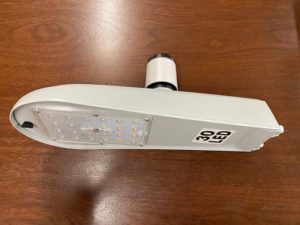Who is a member?
Our members are the local governments of Massachusetts and their elected and appointed leadership.

LEDs installed by the town each have a coffee-cup-sized “Smart Controller.” (Photo courtesy town of Pepperell)
This past winter, Pepperell completed a two-year project to convert 409 streetlights from standard high pressure sodium lights to LEDs and deploy smart technology that allows the town to manage and troubleshoot each individual light from any smart device.
The primary goal was to reduce energy costs, but the project will also result in a better experience for drivers and wildlife, according to Town Administrator Andrew MacLean.
The project resulted from a collaboration between town government and residents. The town considered five possible light signatures, and through a survey chose a 2200 Kelvin lamp option. This lighting level falls in the “warmer” range, emitting a paler yellow light that’s comparable to the original lights, but with less glare. “Cooler” light, at 4000 Kelvin, emits a brighter white light.
“We got a lot of community input on which lights to choose,” MacLean said. “Our lights are more of a yellow signature and that’s a signature that people tend to like and prefer.”
MacLean said the town was one of the first communities to implement the 2200 Kelvin model, which was not available in the quantity the town needed when they started the project — part of the reason the conversion took two years.
“A lesson learned is to take your time with the decision because the technology is changing rapidly,” MacLean said. “Had we done this three years ago, we would have gotten the white signature lights.”
The smart technology uses a small transmitter attached to each lamp to send information and allow the town to control the intensity of each lamp. The technology also notifies the town if a lamp stops working or is compromised by damage to the infrastructure. Currently, the lights are managed day to day by public safety dispatch employees.
“We just call an individual light up on a website and can change the intensity as required at any time of day, or schedule automatic adjustments,” MacLean said.
The town worked with RealTerm Energy, a company that has worked with a number of cities and towns in the state on LED projects of varying degrees. The project cost about $250,000 and has been financed with payments coming from the energy savings.
MacLean said the town has reduced streetlight energy usage by more than 75%, and there are opportunities for future conversions of lights in town parks and play areas.
“Most of the cost is pretty linear,” MacLean said. “The lamp is one price and then labor. The return on investment is seven years, which is longer than we first expected, because we decided to get the smart controllers, which ended up being one third of the cost.”
The town is running the new lights at 30% intensity, he said, “and we did not get one complaint or call from the community.”
The ability to control each light means “we can always make little adjustments.”
“The residents who were pushing us to do this were thrilled,” MacLean said, “and I’m glad we did it. We are saving money.”